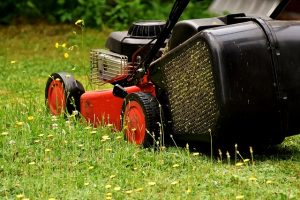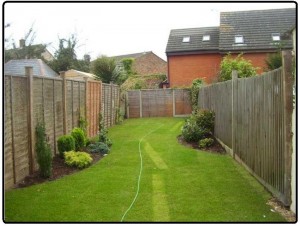Trees take a long time to become established – but is it possible to move them should you ever need to overhaul your garden?
Read more »
A spot of long overdue sunshine does wonders for our sun-loving plants – but the recent dry spell has wreaked havoc on lawns across the country.
Read more »
Hay fever can cast a serious shadow over the sunnier months for allergy sufferers – but what if the culprit of a particularly bad bout could be planted in your back garden?
Read more »
Ivy can look fantastic climbing up the side of a house but it is also very easy to let it grow wildly out of control.
While climbing plants such as ivy are a popular choice to bring character and interest to house and garden walls they do need to be carefully managed.
Read more »
 After the winter lawns can be left looking a little neglected and with the first bursts of sunshine making their presence felt spring is a good time to consider getting your garden ready for summer.
After the winter lawns can be left looking a little neglected and with the first bursts of sunshine making their presence felt spring is a good time to consider getting your garden ready for summer.
Read more »
 Spring is here and hopefully that means some much-need sun along with a healthy dose of rain to get everyone’s gardens flourishing.
Spring is here and hopefully that means some much-need sun along with a healthy dose of rain to get everyone’s gardens flourishing.
Read more »
The end of winter is the perfect time to get ready for the gardening year ahead – it is also the perfect time to prune trees.

Tree pruning is best left until the end of winter when the trees remain dormant ahead of the sap rising as they enter the growth period heralded by the start of spring.
Why prune trees?
Pruning can be essential to maintaining the health of trees and will also help to nurture and guide future growth. Here’s why cutting back makes sense:
Growth
Pruning will help trees continue to grow with good strength; it will also encourage denser growth. Additionally, where areas of a tree have become overgrown pruning will allow you to take control of this.
Damage
With the strong winds and harsh cold of this winter some of your garden trees could have suffered damage. Check all the trees for signs of damage – any that have broken branches will more than likely need to be cut back to allow for re-growth.
Decay/ Disease
Spotting signs of decay and disease in trees is important to managing the health of your garden. Pruning a diseased tree may help to stop the spread of the disease and prevent any dead branches becoming a home for pest insects.
Safety/ Light
This is also a great time to tackle branches that could annoy the neighbours by overhanging their property, or that could pose a threat to safety in the event they break off.
When to call in the experts?
Light pruning to maintain trees is part and parcel of everyday gardening and should be straightforward as long as it is done carefully and in the right conditions. When it comes to bigger trees, however, it is always wise to call in the experts.
A trained tree surgeon will be able to judge exactly what work needs to be carried out – and how this can be done in a safe manner, accounting for the weight of the branches and height of the tree. As larger trees are generally more mature, a tree surgeon will be aware of protecting the tree from any unnecessary damage.
If you need help pruning a tree contact Gardenbusters.
With storms blowing in on a regular basis and frost and ice biting, winter is the time of year when garden fences feel the strain.
If you find the fence around your house is starting to creak under the strain – or in the worst case scenario blows over completely – it could be time to look at having it replaced.

At the very least it will need to be repaired, but before you invest in a replacement make sure you are indeed the owner of the fence.
On many modern housing estates gardens can be bordered by four other properties with a fence in common.
There are many theories floating around about the fence on the right side of the property being the homeowner’s responsibility, or if the good side faces your house.
Know where you stand
While these may well be true in many cases there is no hard and fast rule about garden boundary ownership.
Instead the only place to find an answer that is 100 per cent accurate is in the deeds of your house, which should flag up the boundary that falls under your ownership.
If the deeds are hard to find your best bet is to ask the neighbours which side of the property their fence is on – if you ask a few the pattern should emerge.
Obviously if you are on good terms with your neighbours everything is a lot easier in relation to garden renovation.
Respecting boundaries
But still there are a few fence rules that are worth knowing to keep that friendly neighbourly relationship in good working order:
- Fences should not as a general rule be higher than 2 metres;
- Your neighbour owns the fence on their border entirely and could, if they wish object to painting, trellises and any other fixtures;
- Should your neighbour refuse to repair a fence you have every right to put up an additional fence running alongside it on your property.
There is a lot to be said for good neighbours, particularly when it comes to fence maintenance!
For more information on fencing contact Garden Busters.
It’s that time of year when trees come indoors – yes, Christmas is here and thousands of homes will be furnished with beautiful conifers.

Christmas trees are part and parcel of our festive celebrations and many families are happy to pay anything between £20 and £60 each year for a decent tree.
While the cost may put some people off the idea of investing in a tree every Christmas, there is also the idea of waste. Come the first week in January and there will instead be thousands of sad-looking trees heading for the recycling.
But there is another option – and that is grow your own.
Living Christmas trees
A trend does appear to developing for people decorating trees that remain in their garden – and it’s not just Christmas trees. While lights have been added to beautiful external trees for years, baubles are starting to make an appearance in the garden too.
More notable, Christmas trees are finding a place in family gardens. While for most of the year they stand unnoticed as a conifer, come Christmas these look fantastic with lights added.
Environmentally-aware consumers have also chosen to invest in potted Christmas trees, which while more expensive at the outset obviously cost less in the long-run.
Adding a Christmas tree to the garden
Most living Christmas trees come in a pot for ease of transport and storage. If you choose to opt for a potted version it is advisable to re-pot the tree every year to allow it to grow.
Conifers as a general rule are easy trees to maintain. The only considerations with a potted Christmas tree will be to maintain the shape with regular trimming and keep an eye on the growth of larger branches while removing any that die.
Alternatively, the tree could be planted into the garden from the pot.
To plant a Christmas tree directly into your garden you will need to ensure it has the root ball still attached.
Like potted Christmas trees, once in the ground the tree will be easy to look after and require little maintenance aside of trimming.
Beware though, Christmas trees can grow quickly and substantially – reaching up to 50 feet.
Living trees also need to spend less time inside to avoid being damaged – around 10 days is the average time recommended.
When thinking about your Christmas tree this year, turn your thoughts to the garden and consider whether it would welcome a festive addition.
For any information on tree maintenance contact Garden Busters.
Houses, warehouses, roads – there is a lot of competition for space in our communities but spare a thought for the humble tree.
Development, unfortunately, often comes at a price for nature.
And this is the time that Tree Preservation Orders frequently come into play to protect trees of special interest.

What does a Tree Preservation Order mean?
A Tree Preservation Order is made by a council to protect a tree or woodland from harm or destruction following an application, which anyone is free to make.
If a Tree Preservation Order exists for a tree on your property you need to abide by it or face prosecution.
The order forbids:
- Felling
- Lopping
- Topping
- Uprooting
- Deliberate damage or destruction
In light of the restrictions put in place by a Tree Preservation Order it is often necessary to apply to the borough council to carry out work to any tree that is subject to an order.
Carrying out work on a protected tree
Despite the restrictions in place it is the duty of the homeowner to ensure that the tree is properly maintained.
Carrying out work to a tree under a Tree Preservation Order can involve putting a form together detailing what work is required and why it is needed. Councils do have the right to refuse the work.
When an application for work on a protected tree is approved the council will reply with a written response.
Delicacy and thoroughness are essential to make sure that work is properly carried out when a Tree Preservation Order is in place.
Rather than take on the complicated task yourself it is wise to seek the help of a tree surgeon, who can advise on the work needed and how to go about it.
If you have any concerns about a tree on your property contact Garden Busters for expert advice.








